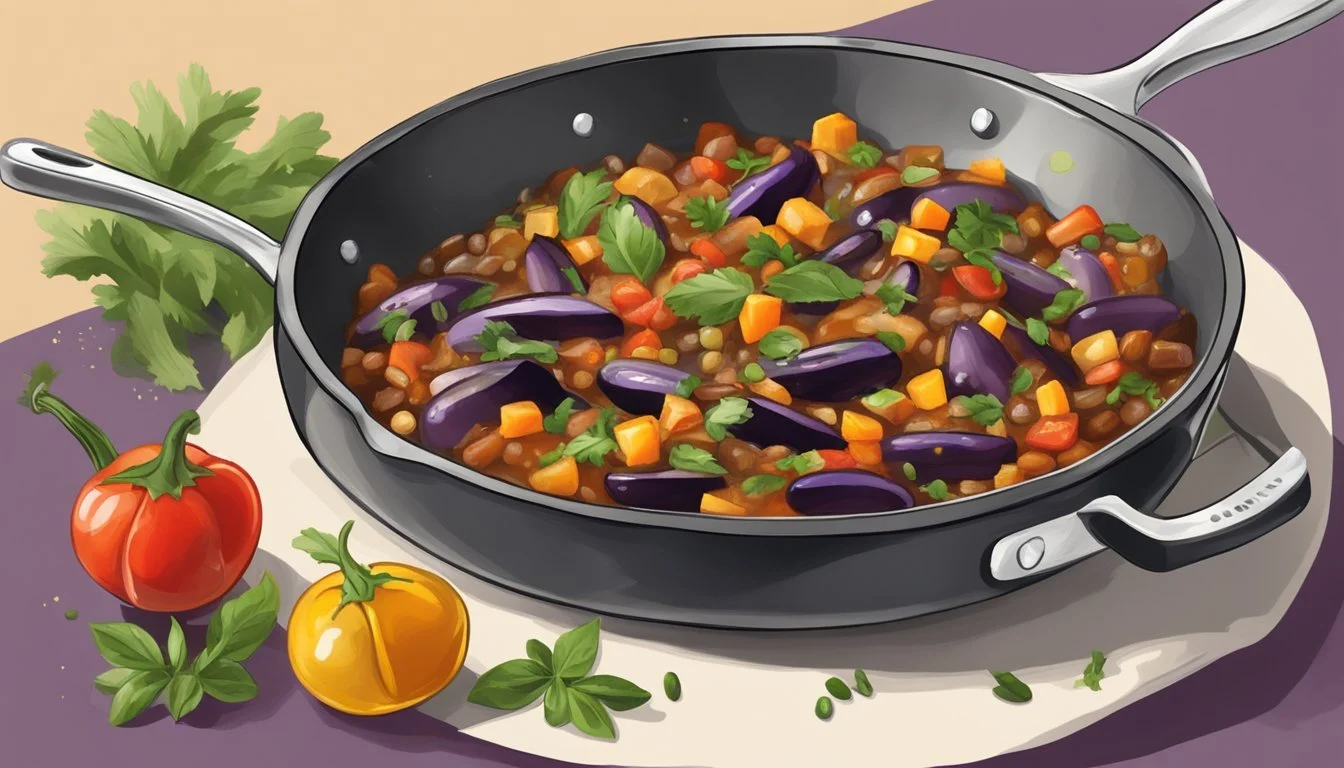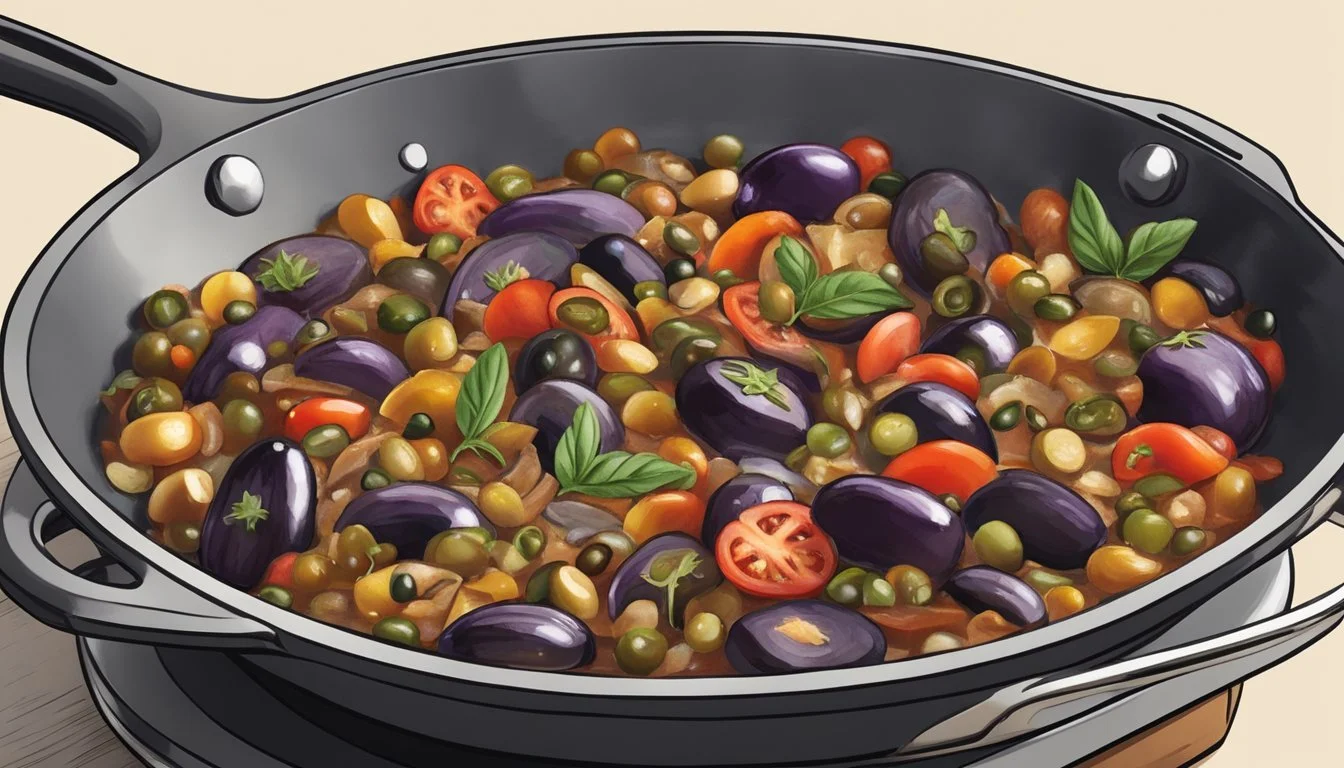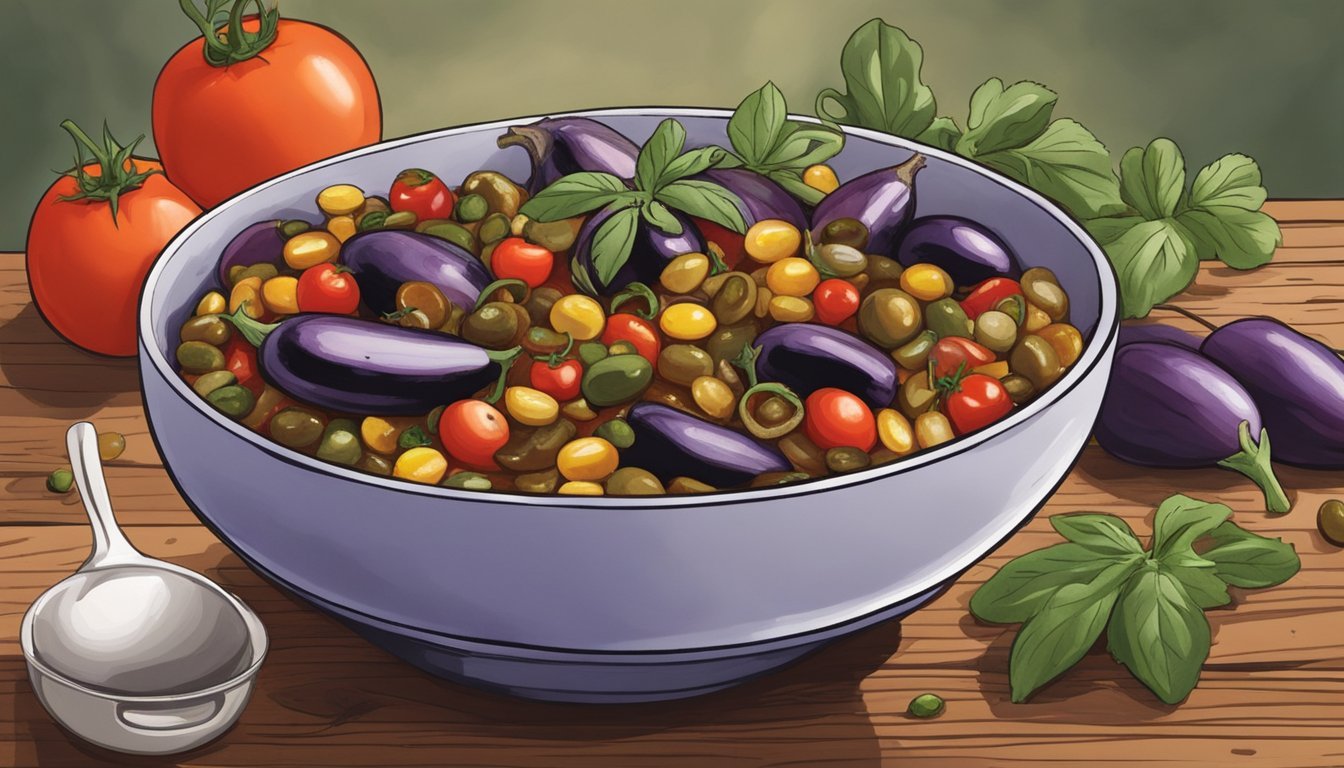Best Way to Reheat Eggplant Caponata
Tips for Preserving Flavor and Texture
Eggplant caponata is a quintessentially Italian appetizer boasting a rich tapestry of flavors. This savory dish, with its roots in Sicilian cuisine, is traditionally a medley of eggplant, tomatoes, and a host of aromatic herbs and vegetables, bathed in a sweet and sour sauce. Due to its robust and complex taste profile, eggplant caponata is not only a standout on its own but also a versatile companion to a variety of main courses. However, like many dishes with layers of flavor, ensuring that reheated caponata retains its signature savory essence requires specific techniques.
Maintaining the integrity of eggplant caponata’s flavors and textures during reheating is pivotal for an encore presentation that echoes the freshness of its initial serving. Whether it is being warmed up for a small family dinner or as a precursor to a larger feast, the method of reheating this Italian appetizer makes a notable difference. Achieving the delicate balance of preserving the tender eggplant while revitalizing the zest of the capers, (What wine goes well with capers?) olives, (What wine goes well with olives?) and the acidic touch of vinegar is key to a successful dish.
Enthusiasts of this Italian classic understand the importance of reheating it just right, so that each component remains distinguishable, yet harmoniously blends when tasted. With a focus on gentle reheating, one can ensure that the caponata not only warms through but also maintains its complexity. Delicate handling during the process is important in order to offer the eggplant caponata as if it were freshly made, brimming with its unique savor, ready to be relished once again.
Historical Background of Eggplant Caponata
Eggplant Caponata is a quintessential Sicilian dish, boasting a rich history that is as flavorful as its combination of sweet and sour elements. Steeped in the traditions of Italian cuisine, every ingredient in Caponata has a story to tell, from the humble eggplant to the tangy capers.
Origins in Sicilian Cuisine
The origins of Caponata are rooted in Sicily, Italy, where it first emerged as a staple dish for seafarers. Historically, the Sicilian pantry staples like eggplant, tomatoes, and olives, paired with vinegar, provided a long-lasting meal that was both nourishing and easy to preserve at sea. Over time, this vegetable medley evolved in Sicilian kitchens, incorporating a variety of local ingredients reflective of the island's vibrant culinary landscape.
Traditional Ingredients and Variations
In its traditional form, Caponata centers around eggplant, accented by a harmony of other ingredients that include:
Celery: for its crisp texture and refreshing taste.
Olives and Capers: for a burst of Mediterranean brine and flavor.
Vinegar: lending the dish its characteristic sweet and sour profile.
Other ingredients often found in this Sicilian dish are onions, which add a foundational layer of savoriness, and tomatoes, contributing a rich, sweet base. Variations of Caponata may also introduce raisins, providing a subtle sweetness, or caper berries, which offer a larger, more succulent bite compared to traditional capers. Each iteration of this classic dish reflects the creativity and regional preferences of Sicilian cooks, making Caponata a testament to Italy's culinary diversity.
Essential Ingredients for Authentic Flavor
For a truly savory caponata, certain ingredients are pivotal. Their interplay is what gives this Sicilian dish its unique and well-balanced profile, combining eggplant with a medley of supporting flavors.
Eggplant: The Star of Caponata
The eggplant, or aubergine, is the backbone of caponata. For best results, one should select firm, glossy eggplants that feel heavy for their size. A crucial step is to salt the eggplant prior to cooking, which helps to remove bitterness and enhance its natural flavor.
The Unmissable Trio: Celery, Capers, and Olives
The dish's complexity comes from the combination of celery, capers, and both black and green olives. Celery provides a crunchy, aromatic bite, while capers and olives contribute a briny depth that is unmistakable. They are often sautéed in olive oil, which itself is a key flavor component.
Celery: Crisp and aromatic
Capers and Olives: Offer a salty, briny quality
Balancing Sweet and Sour: Sugar and Vinegar
The sweet and sour elements are essential to caponata's unique taste. A mixture of sugar and vinegar, frequently red wine vinegar, creates this balance. Variations may include raisins for sweetness and additional layers of flavor, or pine nuts for a subtle nuttiness. This combination is delicately simmered to meld the flavors together.
Sweet: Sugar, raisins
Sour: Vinegar
Utilizing fresh herbs such as parsley and basil in the final stages imparts a fresh, aromatic finish to the dish. Each ingredient in caponata plays a vital role in creating its authentic flavor, making the selection and preparation of these components equally as important as how they are combined and cooked.
Step-by-Step Caponata Preparation
Creating a delicious eggplant caponata requires attention to detail in preparing ingredients, ensuring they come together in a harmonious mix for a rich and savory result.
Dicing and Frying Eggplant for the Right Texture
To begin, choose fresh, firm eggplants to be the backbone of your caponata. They should be diced into consistent 1-inch cubes for even cooking. These cubes are then generously tossed in olive oil, along with kosher salt, and pepper to ensure they're well-seasoned. Fry the eggplant in batches in a skillet or alternatively roast them in a preheated oven at 425°F for 25-30 minutes, or until they are golden and soft. This process highlights the eggplant's texture and brings out a deep, caramelized flavor.
Combining Ingredients for a Harmonious Mix
Once the eggplant is prepared, set it aside while you focus on the base of the caponata. In a large skillet, heat some additional olive oil and then sauté diced onions, minced garlic, chopped celery, and bell peppers until softened. Incorporate ripe tomatoes, a blend of olives and capers, and a spoonful of tomato paste into the mix. The tomato paste will deepen the flavor profile, while olives and capers introduce a savory contrast to the sweetness of the eggplant.
Seasoning and Simmering to Perfection
Introduce a touch of sweetness with golden raisins, previously soaked in vinegar to soften. Add them to the skillet along with fried or roasted eggplant. Now, pour in tomato sauce and a drizzle of red wine vinegar, which brings a subtle acidic edge. Sprinkle in salt and black pepper for flavor balance. Allow the mixture to simmer, melding the flavors together. Finish the caponata with freshly torn basil and parsley for a burst of freshness. The simmering stage is crucial for the ingredients to integrate and for the caponata to achieve its characteristic depth and complexity.
The Science of Reheating: Retaining Texture and Flavor
When reheating eggplant caponata, the priority is to preserve its roasted texture and savory flavor. The wrong reheating method can lead to a dish that's either too soggy or dried out, losing the complexity that defines caponata.
Choosing the Right Reheating Method
For optimal results, a conventional oven is recommended. Reheating in an oven allows for an even distribution of heat, which helps maintain the texture and flavor of eggplant caponata. The eggplant should remain tender without becoming mushy. Here's a guideline for oven reheating:
Preheat the oven to 350°F (175°C).
Place the caponata in an oven-safe dish.
Cover with foil to prevent drying out.
Heat for about 10-15 minutes, checking to ensure it's heated through.
A skillet can be used for smaller portions or for a slightly crisped exterior. The steps are:
Heat a skillet over medium heat.
Add a small amount of olive oil or cooking spray to avoid sticking.
Add the eggplant caponata, stirring gently to heat evenly.
Reheat for 5-7 minutes until it's warmed to your satisfaction.
Avoiding Common Reheating Mistakes
To avoid compromising the dish's texture and flavor:
Do not overheat: Overheating can break down the eggplant, making it too soft.
Avoid the microwave: Microwave techniques can cause uneven reheating, which is particularly detrimental to dishes like caponata that rely on a balance of textures.
Skip direct high heat: Using a skillet? Reheat on a lower setting to avoid burning any of the tender eggplant pieces.
Stir occasionally: This prevents sticking and ensures even reheating.
By carefully selecting the reheating method and avoiding common errors, one can ensure that the texture and flavor of eggplant caponata are as delightful as when it was first made. Whether served atop bread for bruschetta, alongside pasta, or even on pizza, reheated caponata can rival the freshly made experience.
Best Practices for Storing and Reheating Eggplant Caponata
Maintaining the texture and flavors of eggplant caponata relies on proper storage and reheating techniques. This section offers guidance on how to keep caponata tasting like it’s just been made.
Proper Storage Tips
Eggplant caponata should be stored in an airtight container to retain its freshness. If the caponata has just been cooked, they should allow it to cool to room temperature before placing it in the fridge. This prevents condensation that could make the dish soggy. It's best stored in the fridge to slow down the degradation process.
Refrigerator Storage: Seal the caponata in a container and refrigerate for up to 5 days.
Freezer Storage: For longer storage, caponata can be frozen. Here, one should portion the caponata into servings before freezing, making the reheating process simpler.
Reheating Guidelines for Optimal Flavor
The reheating process should carefully restore the caponata without degrading the taste or texture. Using a moderate heat source is key.
Oven Reheating: Preheat the oven to 350 °F. Spread the caponata in an oven-safe dish and heat it, covered, for about 5-10 minutes. If it contains bread, the caponata should be covered with foil to avoid drying out the bread.
Stovetop Reheating: Add a small amount of olive oil to a skillet over medium heat and gently warm the caponata, stirring occasionally to prevent sticking.
If the caponata was preserved with canned tomatoes, one should look out for any acidity reduction during reheating and adjust seasoning as necessary. Do not reheat caponata more than once as it can compromise the flavor and safety.
Creative Ways to Serve Reheated Caponata
Reheated Caponata can transform into a versatile element in a meal, offering a mix of tangy and savory flavors that pairs well with various dishes. Whether it’s repurposed as an appetizer or as a side, there are innovative ways to present this Italian staple.
Serving Ideas Beyond the Traditional
Caponata traditionally compliments crusty bread as a robust appetizer. However, one can elevate its role by using caponata atop crostini for bite-sized delights, or as a topping for a chicken Milanese entree. Introducing caponata to pasta dishes creates a delicate balance, mixing it with fresh pappardelle for a more sumptuous appeal.
Crostini: Just spread it on top before serving.
Pasta: Mix it in with freshly cooked pappardelle.
Pairing Suggestions
When considering pairing caponata, one should look to items that complement its sweetness and acidity. Grilled salmon or oven-roasted chicken as a main course emphasize the caponata’s richness without overpowering the flavors. For a more vegetable-centric meal similar to ratatouille, combine it with an assortment of roasted veggies as a side dish.
Main Course:
Grilled salmon
Oven-roasted chicken
Side Dish:
Assorted roasted vegetables
By employing these creative serving and pairing ideas, reheated caponata can easily become a versatile component that enhances a range of meals, from the simplest of snacks to the most elaborate of mains.
Nutritional Insights and Health Benefits
Eggplant Caponata, a traditional Mediterranean dish, is not only flavorful but also packed with nutrients beneficial for a balanced diet. Its ingredients contribute a rich profile of vitamins, minerals, and dietary fiber.
Macronutrient Profile of Eggplant Caponata
Eggplant Caponata is a composite dish with a varied macronutrient profile. A typical serving size could contain:
Calories: Ranges, depending on the amount of olive oil and other ingredients used.
Fiber: A high-fiber dish, primarily from eggplant and other vegetables.
Protein: Minimal; eggplant and other vegetables provide some protein.
Eggplant itself is low in calories and high in dietary fiber, making it a weight-conscious choice. The dish includes multiple fiber-rich ingredients, which can aid in digestion and help maintain a healthy gut. The overall calorie count can be moderated by adjusting the amount of olive oil used.
Eggplant Caponata in a Balanced Diet
In the context of healthy eating and a Mediterranean cuisine framework, Eggplant Caponata fits seamlessly due to its composition of vegetables and healthy fats. It is:
Rich in Antioxidants: The variety of vegetables, particularly eggplant, boasts a range of antioxidants.
Vitamins and Minerals: Provides essential nutrients such as vitamins A, C, K, and minerals like potassium and magnesium.
Integrating Eggplant Caponata into one's diet contributes to the intake of vital nutrients while aligning with the principles of Mediterranean dietary patterns, which are known for their health benefits. This dish exemplifies how eggplant recipes are not only central to Mediterranean cuisine but also to a health-conscious lifestyle.
Variations and Innovations in Caponata Recipes
Eggplant Caponata is a versatile Sicilian dish that welcomes a tapestry of ingredients, each variation reflecting regional tastes or modern culinary trends.
Regional Differences in Caponata Preparation
In Italy, regional recipes for Caponata vary with local produce and historical influences. For example, Sicilian Caponata typically features eggplant, celery, onions, and a sweet and sour sauce. Variations might include:
Western Sicily: Abundance of tomatoes and a sweeter sauce.
Eastern Sicily: Inclusion of fish or seafood for a coastal twist.
Central Sicily: Often spicier, with chili peppers enhancing the mix.
Key ingredients like eggplant, bell pepper, and extra virgin olive oil remain constants, while others are swapped or added according to local preference.
Modern Twists for Contemporary Palates
As Caponata has entered the realm of modern cuisine, chefs and home cooks have begun infusing the classic with innovations:
Sweeteners: Replacing traditional sugar, some use honey or agave for nuanced sweetness.
Vinegars: Balsamic vinegar is sometimes chosen over the typical white or red wine vinegar for its rich complexity.
Herbs and Spices: Fresh herbs like basil or mint give a contemporary zing to the dish.
Textures and Colors: Think toasted nuts for crunch, or golden raisins for a pop of color and sweetness.
Contemporary Caponata also often highlights kitchen creativity by incorporating less traditional vegetables or experimenting with different cooking methods to enhance the dish's flavor profile.
Conclusion
Eggplant Caponata, a quintessential Italian dish, is a medley of flavors ranging from savory to briny and tangy. Its rich history in Italian tradition makes it not just a meal but a culinary experience. To preserve the integrity of its intricate flavors during reheating, careful attention must be taken.
One might consider the oven method, preheating it to 350°F, then gently warming the Caponata until it reaches the desired temperature. This method ensures that the dish heats evenly while maintaining its moisture.
Microwave reheating is a viable option for its convenience. A microwavable container, slightly ajar, offers a fast solution to restore the caponata's warmth. However, taste and texture may vary when compared to gradual oven heating.
For the enthusiast seeking to rekindle the dish's essence, the skillet method suggests a balance: reheating over medium heat assures that each element reactivates its robust flavor profile.
In all methods, stirring should be gentle and regular to avoid crushing the tender pieces of eggplant and to ensure an even distribution of heat. The goal is to uphold the caponata's integrity—both in tenderness and taste.
Reheating Eggplant Caponata, when done thoughtfully, can closely echo the delight of the dish's initial serving, allowing its savory, briny, and tangy components to flourish once more on the palate. Savvy diners who cherish the subtleties of Italian cuisine can thus draw pleasure from the Caponata, not only upon first taste but also when savoring leftovers.










